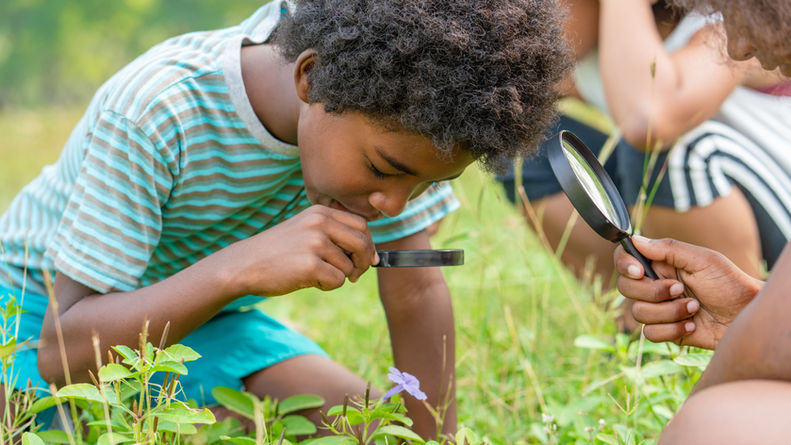
FAMILY ACTIVITIES.
NATURE CONNECTION FOR THE FAMILY
With video games, social media, smartphones, and 24-hour entertainment all vying for your child’s (and let’s be honest, all of our) attention, spending time in Nature, and cultivating a lifelong love of the natural world, is more important than ever.
Being outside helps children grow confidence, spark creativity, build resilience, and feel a deep connection to the world around them. This is vital, not just for your family’s wellbeing, but for the planet’s future too.
This page has just a few simple, fun Nature-based activities to help you and your family get curious, explore, and find joy in the amazing natural world.

MEET A TREE.
Get to know a local tree with our fun game. You will need: – A partner to play with – A blindfold – A selection of trees Your guide will choose a tree and lead you to it while your eyes are covered. Take one minute to explore the tree with your hands, nose and ears. No peeking! When time’s up, your guide will return you to your starting point and spin you around. Can you work out which tree you met? Then swap roles. What it teaches: Trust, sensory awareness, and building a relationship with Nature.
SHADOW ART.
Celebrate the sun with this creative way to play with light and shape. You will need: – A piece of paper – A pencil – Colouring pens or pencils (optional) Head outside in the morning or late afternoon when shadows are long. Look for interesting shapes cast by flowers, trees or other natural objects. Place your paper under the shadow and carefully trace around it. You can colour it in or decorate it however you like to create your own piece of Nature-inspired art. What it teaches: Observation, creativity, and appreciation of sunlight and time of day.
BARK RUBBING.
Explore trees through texture and pattern. You will need: – Sheets of blank or recycled paper – Wax crayons or colouring pencils Find a few trees with different types of bark — bumpy, smooth, cracked, or patterned. Press your paper gently onto the trunk, then rub your crayon across the surface. Watch the bark’s pattern appear. Try using different colours or combining rubbings to make a textured collage of tree designs. What it teaches: Attention to detail, sensory connection, and an eye for Nature’s hidden designs.
WILD SPOT SIT.
Discover what happens when you’re still in Nature. You will need: – A quiet outdoor spot – A timer (or just count slowly) – A notebook or drawing pad Find a place to sit quietly for five minutes. Pay attention to everything around you — what can you hear, smell, feel or see moving? Try not to talk or fidget. Afterwards, you can draw or write what you noticed. Visit the same spot another day and see what’s changed. What it teaches: Calm focus, patience, and a stronger sense of place.
FORAGE & FEAST.
Discover wild flavours and connect with the land. You will need: – A grown-up helper – A basket or container – A plant identification guide or app (optional) Go for a walk and look for safe, edible plants like blackberries, wild mint, or edible flowers. Only pick what you’re sure is safe, and always check with an adult first. Collect a small amount to take home. Use your finds to make a simple snack or drink — like a berry salad, mint water, or flower-decorated treats. What it teaches: Respect for Nature’s gifts, understanding of wild food, and a deeper connection to the seasons.
BUG HOTEL OR BUTTERFLY CAFE.
Create a cosy hideaway for tiny garden guests. You will need: – Natural materials like sticks, leaves, bark and pinecones – A small box, flower pot or tin can – A sheltered spot outside Layer your natural materials inside the container to make small nooks and crannies. Tuck your bug hotel into a quiet, shady place and wait. Check back later to see if any insects have moved in — like beetles, spiders or ladybirds. What it teaches: Care and empathy for small creatures, awareness of habitat, and observation skills.
WHAT TO LOOK FOR THIS SEASON


Changing Leaves
Trees begin their autumn transformation, with leaves turning gold, red, and copper. Look for species like maples, oaks, and sycamores. Fallen leaves create a crunchy carpet and provide habitat for insects and fungi.
Migration & Birdwatching
Many bird species start migrating, including swallows, swifts, and some geese. Watch for flocks gathering in fields or along coastlines, and listen for the calls of returning thrushes and redwings.

Hedgerow Harvests
Fruits and nuts are abundant. Blackberries, elderberries, sloes, and hazelnuts ripen. Many small mammals, such as squirrels and hedgehogs, begin storing food for the winter.

How do you connect with Nature as a family?
We love to hear from you! Send us your comments, photos or artwork to support@treesisters.org. or tag us on social media.














